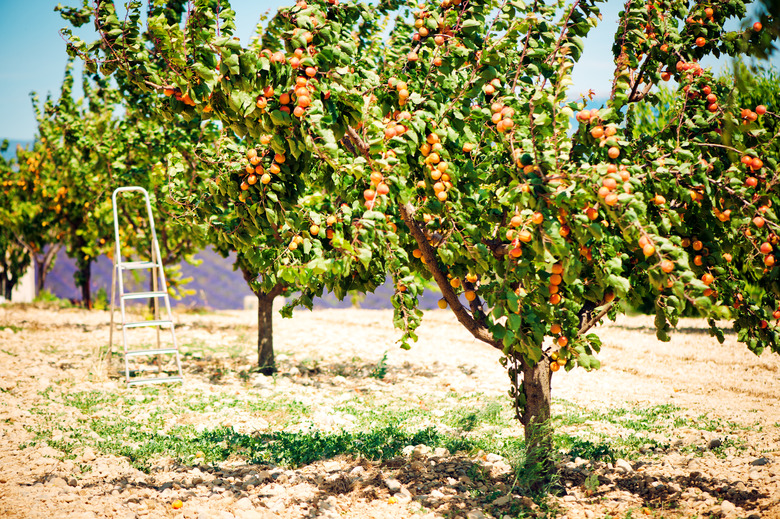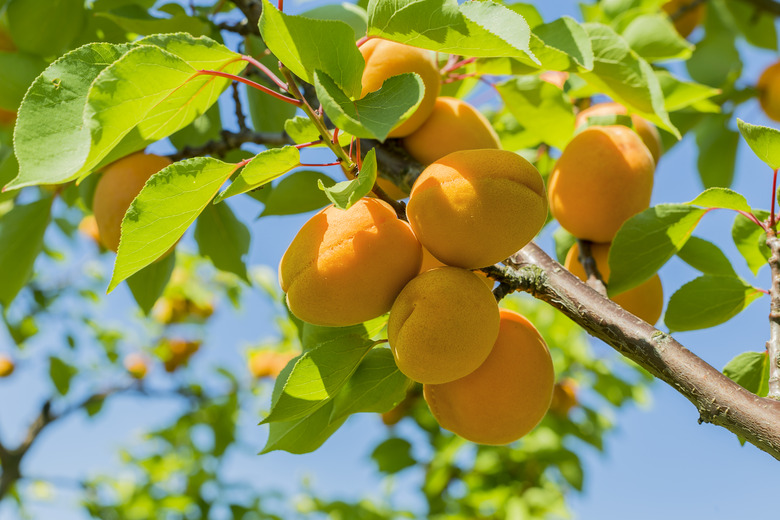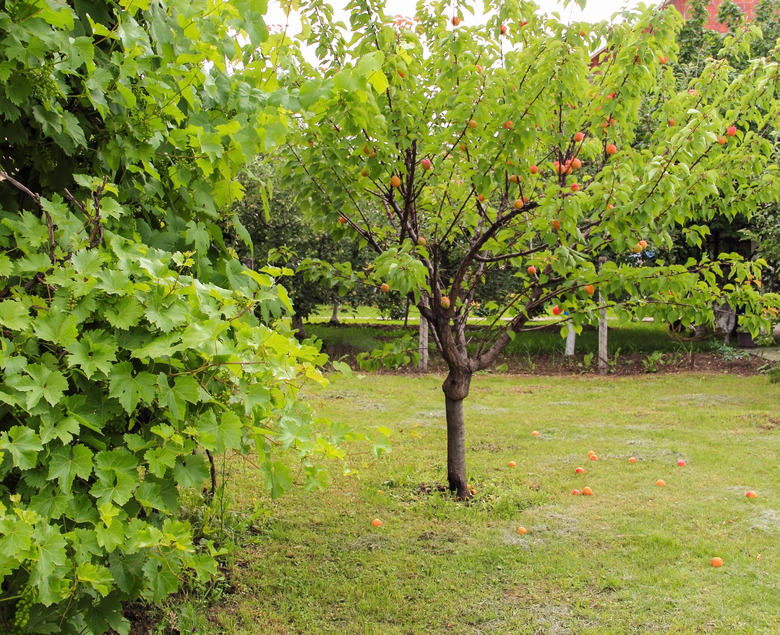How To Grow Apricots
We may receive a commission on purchases made from links.
Delightfully sweet with just a hint of tang, apricots (Prunus armeniaca) are a must-have in the home orchard across this plant's hardiness range in USDA zones 5 through 8. Apricot trees are some of the very first fruit trees to bloom in the spring, and as such, they are ready to harvest earlier in the summer than other fruits. In its prime, a single tree can easily produce fruit in excess of 150 to 200 pounds every year. Dwarf varieties produce 50 to 100 pounds, so you'll have plenty of apricots no matter what size tree you choose.
Best Uses for Apricots
Best Uses for Apricots
Like other trees in the home orchard, apricots serve as a source of delicious, homegrown food. With proper care, apricot trees live 40 to 150 years, although a typical lifespan is 20-40 years. They begin setting fruit two to four years after planting and usually continue to do so for at least 15 years.
Because they produce so much fruit, you may only need one tree. The Prunus armeniaca 'Perfection' and P. armeniaca 'Riland' cultivars require a second tree within 300 feet for successful pollination. Other varieties will self-pollinate, but it's a good idea to plant a second tree anyway since it will increase your tree's production.
Don't worry that two trees will leave you drowning in apricots. You can eat these versatile fruits fresh, or you can freeze, can and dry them. This gives you lots of storage options. You can also give away some apricots. Most people won't turn down a gift of fresh, homegrown apricots. Some food banks are also willing to accept donations from home orchards.
How to Grow Apricots
How to Grow Apricots
- Common Name: Apricot
- Botanical Name: Prunus armeniaca
- When to Plant: In spring after the danger of frost passes
- USDA Zones: Best in zones 5-8
- Sun Exposure: Full sun
- Soil Type: Loamy, very well-drained soil
- When it's in Trouble: Wilted and yellowing leaves, low-quality fruit
- When it's Thriving: Bright-green leaves, healthy fruit set
Starting Apricots From a Sapling
If you're very patient, you can plant the seed (also called a pit or stone) from within an apricot and grow your own plant from seed. The process is time-consuming, however, and greatly extends the time between planting your tree and harvesting it. Even more important is the likelihood that a seed-grown apricot tree will not produce fruits that are similar in size, quantity, and quality as its hybrid parents. It's much quicker and easier to plant young apricot trees, which you purchase from a reputable grower.
To plant your tree, choose a sunny spot that's protected from wind. Make sure your tree will also have plenty of head room, as fully grown apricot trees reach heights of 20 to 30 feet. In cooler climates, planting near a south-facing wall is ideal. Make sure your soil drains well before you plant. Apricot trees don't tolerate wet feet (soggy roots), so amend your soil with sand or peat moss if it's heavy.
Dig a planting hole just as deep and twice as wide as the tree's root ball. If you plan on staking the tree, drive the stake(s) at least 2 feet into the ground at the side of your planting hole.
Place the apricot tree into the hole so that it sits at the same depth it did in the original container. If your tree was wrapped in burlap, look for the line on the trunk where the plant was in soil previously and plant it to that depth.
Backfill the planting hole with the native soil you removed when digging the hole. Tamp down the soil well to avoid air pockets. Attach your tree to the support stake(s) if necessary using tree ties. Water your new tree thoroughly. If desired, you can mulch around your apricot tree to a depth of about 3 inches. If you're planting additional apricot trees, make sure you space them at least 20 to 25 feet apart. Dwarf apricots need only 12 to 15 feet of space.
In What Zone Do Apricots Grow Best?
In What Zone Do Apricots Grow Best?
Like many fruit trees, apricot trees need a period of winter dormancy to grow well and set fruit. For apricots, this means 600 to 900 hours per year in temperatures between 32 and 45 degrees Fahrenheit. As a result of this need, apricots grow best in USDA plant hardiness zones 5 through 8, although gardeners in some areas of zones 9 and 10 may also be able to grow them successfully.
Ideally, apricots like fairly cold winters where late freezes are unusual. Warm summers are also appreciated, but temperatures above 100 degrees Fahrenheit are not. A summer low in humidity with little rainfall is perfect.
If you're not sure which apricot variety to grow in your area, visit your local garden center rather than buying your plants online. Local stores don't tend to stock plants that won't grow well in your area, so they're a great resource when you're unsure of which apricot variety to plant.
When Should You Plant Apricots?
When Should You Plant Apricots?
Plant bare-root apricot trees as early as you can in the spring. Wait until the danger of frost has passed but get to planting as soon as the soil is warm enough to be workable. The goal is to get the tree in the ground while it's still dormant.
Trees wrapped in burlap or planted in nursery containers also prefer a spring planting. These trees are a bit more forgiving, however, and will be OK as long as you plant them before the heat of summer kicks into gear. You can also plant them early in the fall. Give them a few weeks to get acclimated before winter, though.
Soil, Sunlight and Water Recommendations for Apricots
Soil, Sunlight and Water Recommendations for Apricots
Apricot trees absolutely love a sunny spot with rich, loamy soil with a pH range of 6.7 to 7.5. During their first year, water your apricots deeply about once a week. After that, you'll only need to water when nature fails to provide an inch of water every 10 days. The best way to water is to let the water from your hose slowly trickle out at the base of the plant until the entire area around its roots is wet. When in doubt, skip the water because overwatering apricots is far worse than underwatering them.
It's best to fertilize your tree according to the results of a soil test. In the absence of a test, apply a balanced 10-10-10 fertilizer early in the spring as new growth forms. Watch for flowers in the spring and watch the weather. A late frost will kill the budding flowers and severely limit fruit production. Cover the tree with a tree cover or tarp if frost is expected after the flowers start forming.
Late in the spring, when the apricots on your tree are about the size of marbles, thin them. Leave 2 to 3 inches between each fruit. If you fail to thin the budding apricots, this year's apricots will be smaller than usual, and you may get little or no fruit next year.
Prune your apricot tree in the late winter or early spring each year. To prune a fruit tree properly, utilize a vase approach. Do so by choosing three or four branches that start about 24 inches above the ground. Choose branches that are spaced evenly apart around the tree. Keep your chosen branches and prune away the other main branches in the middle of the tree.
Doing this allows more light to reach the interior of the tree so you can get better fruit. It also allows air to circulate better within the tree's structure, which helps minimize fungal diseases that prosper in moist conditions. All of your remaining stems and branches will be part of the 3 or 4 main branches that you left on the tree. Continue pruning, removing any dead or damaged branches as necessary. Once you've established the vase shape of the tree, subsequent pruning should help keep the proper shape. Never remove more than 25 percent of the branches at a time.
How to Winterize Apricots
How to Winterize Apricots
Apricot trees are deciduous, meaning that in the fall, they'll drop all their leaves and go dormant. You need not do anything for them during these dormant winter months. Your tree may need some help in the spring, however.
Newly formed leaves and flower buds can die if a late frost comes early in the spring. If your area is expecting a frost after your tree has started to blossom, cover it with a tarp overnight to keep it warm. You can also wrap it in outdoor incandescent Christmas lights to help keep it warm. Make sure you don't use LED lights, as these won't create the heat you need.
How to Harvest Apricots
How to Harvest Apricots
The apricot harvest is an exciting time, but resist the urge to pluck off all the apricots as soon as you can. Apricots taste their best when allowed to ripen on the tree. In warm areas, you can start harvesting your apricots in July. In cooler areas, they may not be ready until August.
Apricots are ready when they're a nice yellowish-red color, and the skin gives a bit when gently pressed. To test an apricot, cup it in your hand and give it a slight twist. Fruits that are ready for harvest will pop right off the tree. Apricots that don't pop right off the tree aren't quite ready yet.
Once the apricot harvest begins, it typically lasts about three weeks. Leave your apricots on the tree as long as you can, plucking them only when you're in the mood for a tasty treat. When the fruit production is over, pick as many apricots as you can and freeze, dry or can them to enjoy during the winter. You can store fresh apricots in the refrigerator for three to five days.
Common Pests and Other Problems for Apricots
Common Pests and Other Problems for Apricots
Unfortunately, you're probably not the only creature in your garden that likes apricots. Aphids, spider mites, Japanese beetles, thrips and scale insects also like to munch on apricot trees. Oriental fruit moths, leafrollers and caterpillars may also pay your trees a visit.
Insect visitors are par for the course when growing fruit trees. The best way to protect your trees is to periodically treat them with horticultural oil. Treatment frequency depends on the product you use, so follow the instructions carefully.
Birds can also cause problems by eating your fruit or munching on flower buds before they get to fruit. Bird netting is the simplest and cheapest solution for this problem.
Common Diseases for Apricots
Common Diseases for Apricots
Apricots aren't susceptible to any special disease. Like all plants, however, rots, fungi and viruses can impact their health. As always, the best way to deal with these issues is to prevent them with good garden practices.
Space your trees as recommended to allow proper airflow and don't interact with them when they're wet. Direct all of your irrigation efforts at the base of the tree and avoid wetting the leaves and fruit through overhead watering. Rake fallen leaves and other garden debris around the tree and clean up dropped fruit promptly. If you mulch around your tree, make sure the mulch doesn't touch the tree's trunk.
Many of the diseases that impact apricot trees have no cure, so preventing them with good garden hygiene is imperative. You should also watch for any signs of disease, such as leaf spots or cankers, and prune them out of the tree as soon as you see them. A fungicidal copper spray can help with some diseases and is always worth a try, but it may not save infected plants. Be sure to check the product label to make sure it doesn't contain sulfur, a fungicide, which should never be used on apricot trees.


